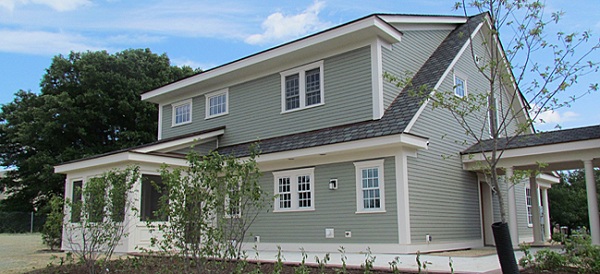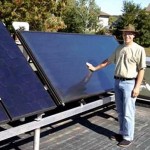NIST House looks and feels like a regular house but actually it is a state of the art Net Zero Energy residential test facility; a 2,700 square foot lab at the campus of National Institute of Standards and Technology (NIST), in Gaithersburg, MD. Yes, a true energy nerd’s paradise.
Folks who built it believe “Nothing lost is everyone’s gain.” I agree, sounds a bit cliché but its an awesome idea! The research facility that cost $2.5 million, showcases how the most energy-efficient, commercially available products can be deployed to create an attractive home that actually produces as much energy as it uses over the course of a year.
There is one catch though, no strange humanoids will actually live here because it will be populated by a virtual family of four – two working parents, a 14-year-old and an 8-year-old. A special program scripted their every move – cooking meals, taking a shower, playing Nintendo, even dad browsing the internet late at night (joking). They even went as far as to install small devices that will simulate the heat and humidity that humans emit in the two-story, four-bedroom structure.
“This family is very cooperative, they do exactly what we want them to do, every minute of the day,” Hunter Fanney, chief of NIST’s Building Environment Lab, said at the project’s official launch last week.
NIST’s main goal is to demonstrate that a home similar in size and looks, can achieve a net zero goal – (zero energy bills) but with all the comforts of a standard home. We’re talking microwaves, ovens, dish washers, laundry machines, heating, cooling, the whole enchilada, all fed by the home’s renewable energy sources like photovoltaics, geothermal heat pump, solar thermal water heating, and smart metering.
Fanney also says, “This house will allow the institute to develop energy-efficient building standards and test procedures in a more real-world environment.”
The NIST website reported that from July, when the first net-zero energy test year began, through October, the house was generating a surplus of electricity every month. In November and December, production had dipped into the red but at the six-month mark, it remained on the plus side of the ledger. You can read monthly summaries of energy use at the NIST web page devoted to the project.






 Cash for Appliances Program is Expiring but There’s Still Time!
Cash for Appliances Program is Expiring but There’s Still Time! Passive House Owner Claims He is Being Ripped Off by His Own Co-op for Generateing Extra Power
Passive House Owner Claims He is Being Ripped Off by His Own Co-op for Generateing Extra Power Portable Prefab Cubes Shipped Via a Truck or Freight Helicopter Near You
Portable Prefab Cubes Shipped Via a Truck or Freight Helicopter Near You